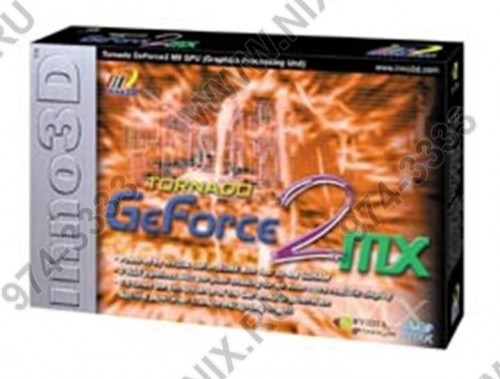GeForce 2 MX

Recall that the memory frequency of the NVIDIA GeForce 256 SDR was the same 166 MHz, only the chip frequency was 120 MHz, not 175 MHz. Thus, in the face of NVIDIA GeForce2 MX, in terms of 3D applications with multitexturing support, gamers got an overclocked GeForce 256 SDR plus several new features. However, with a general similarity, these are still completely different GPUs. First of all, because the core of the GeForce2 MX is from the GeForce2 GTS, which means the presence of the NSR block. So far, NSR support hasn't mattered much, until the release of DirectX 8.0 and drivers that support this toolkit, as well as games that implement the capabilities of the new API set. Nevertheless, the NSR block had a good potential, and its presence could be attributed to the positive features of the GeForce2 MX.
Among the new features that are unique to the GeForce2 MX and not supported by the GeForce 256 and GeForce2 GTS, first of all, we should note the support for TwinView technology, that is, the ability to display an image simultaneously on two receivers (for example, two monitors or a monitor + TV, etc.). ), and DVC technology, which made it possible to obtain an image of perfect quality with support for a constant and adjustable color gamut in all video modes, that is, there is no need to constantly adjust the gamma in different games, the user forgot about "darkness" in OpenGL games, etc.
Specifications NVIDIA GeForce 2 MX
| Name | GeForce 2MX |
| Core | NV11 |
| Process technology (µm) | 0.18 |
| Transistors (million) | 19 |
| Core frequency | 175 |
| Memory frequency (DDR) | 166 (333) |
| Bus and memory type | SDR-128 / DDR-64bit |
| Bandwidth (Gb/s) | 2.7 |
| Pixel pipelines | 2 |
| TMU per conveyor | 2 |
| textures per clock | 4 |
| textures per pass | 2 |
| Vertex conveyors | No |
| Pixel Shaders | 0.5 (emulation) |
| Vertex Shaders | 1.0 (emulation) |
| Fill Rate (Mpix/s) | 350 |
| Fill Rate (Mtex/s) | 700 |
| DirectX | 7.0 |
| Anti-Aliasing (Max) | SS-4x |
| Anisotropic Filtering (Max) | 2x |
| Memory | 32MB |
| Interface | AGP4x |
| RAMDAC | 350 / 150 MHz |
The new chip from NVIDIA did not shine with high-speed qualities due to slow memory, so cards based on it were a kind of compromise between a productive 3D accelerator and a board that provides the user with an additional service in the form of good 2D quality, which is available in almost all video cards of this class. TV, output to digital monitors and TwinView technology.





